8 August 2025
Best Moths for a Haunted Abbey
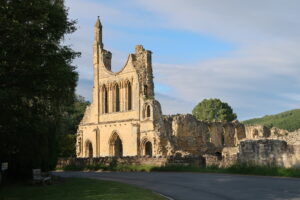
A short walk from Shandy Hall looms the Gothic ruins of Byland Abbey, a site I frequently explore in the evenings after things wrap up here. If I sit long enough in the meadows between the medieval stone walls, I often see moths begin to flutter as the sun dips behind the Hambleton Hills. A wonderful atmosphere for ghost stories.
North Yorkshire has deep links with the Gothic novel, and these books’ tradition of setting tales in architectural ruins and haunted buildings made me wonder how moths may appear in the somber stories I’ve become so familiar with. Perhaps local authors laid eyes on a few of the same moths I’ve been tracking this summer.
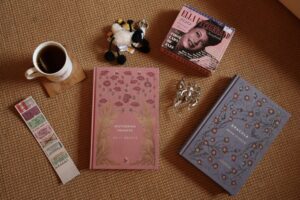
It turns out moths appear abundantly throughout gothic art and literature, though often as bad omens or associations with death. Bram Stoker sets part of his novel Dracula, in which the titular character sends moths to his deranged servant Renfield to ingest, in nearby Whitby Abbey. In Emily Brontë’s Wuthering Heights, written on the nearby moors, Mr. Lockwood sees moths fluttering around the unrestful graves of Heathcliff and Cathy.
I suspect I’m not the only one who lingers in the ruins—Byland, Rievaulx, Whitby—and wonders who walks there after dark. Perhaps a few ghosts, but surely an abundance of moths: scaled keepers of the night so often tied to themes of secrecy, transformation, and decay. The Gothic tradition gave us haunted castles and doomed lovers, but it also gave us an ecology of the overlooked.
Going through the guests in our moth trap, I decided to investigate which moths I had met that morning would most likely take up residence in a haunted abbey if given the chance. These are the moths most at home in ruined sanctuaries.
Moths You Might Encounter in a Haunted Abbey
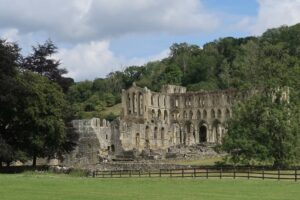
Ruins are not dead; they are simply uncultivated. Their crumbled walls and unmown meadows create habitats for plants no one bothers to weed: brambles, dock, hawkbit, ragwort. Wild grasses spill into cloisters. Cracks in the stone harbor moss, lichen, and a quiet, seeping damp.
These places teem with the kinds of food plants moths (specifically their larvae) love, and the shadows they prefer. Just like the ghosts that are said to haunt Byland Abbey (recorded by an enterprising monk in the 14th century), moths appear suddenly, silently, often at the edges of vision. They are, in many ways, quintessential Gothic presences.
Each of the moths below is linked to wild plants that grow in or near abbey ruins. But more than that, they each carry with them a kind of quiet symbolism: winged metaphors for loss, memory, and strange beauty.
Dark Arches (Apamea monoglypha)
This deep-brown moth slips through and feeds on the high grasses of moorland and overgrown graveyards, home to cock’s-foot, common couch, and other coarse, windblown species that thrive where no one gardens anymore.
Its name, Dark Arches, evokes the images of ribbed vaults of abbeys and the weight of death suspended in stone. A fairly common moth, it often rests in cryptic stillness, perhaps in the shade of a wall niche or under an eave. In that stillness, Dark Arches is suspended between light and shadow, body and spirit, life and death.
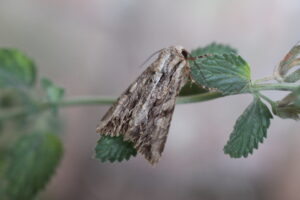
Even its scientific name echoes old sanctity. Apamea was a town in Asia Minor once home to early Christian mystics. In the north, where darker forms predominate, this moth belongs entirely to the landscape of brooding skies and spectral stone.
Dusky Sallow (Eremobia ochroleuca)
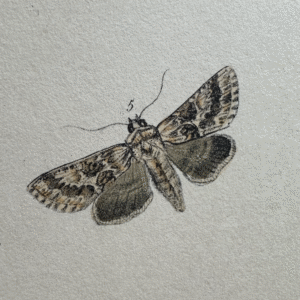
With wings the color of faded vellum or melted candles, the Dusky Sallow is the sickroom moth, the shade that clings to deathbeds and dreams. Its food plants, chicory and hawkbit, grow where the ground is poor and the sunlight hard, in dry earth scattered with rubble.
The name reads like an obituary: Dusky for the waning light, Sallow for the skin of the dying. I can imagine it landing lightly on Cathy’s sleeve in Wuthering Heights, moments before her descent into fevered half-life and crazed visions. Its genus, Eremobia, means “solitary life,” from the Greek eremos (deserted) and bios (life). To me it evoked a sense of a recluse, a mourner, a quiet attendant of decay.
The Magpie (Abraxas grossulariata)
Garish and jittering, the Magpie moth is chaos in silky scales. Black and gold blotches on white wings make it look like shattered stained glass, reassembled in a deranged frenzy. Most abundant on northern heather moorland, it feeds on gooseberry and currant hedgerows that can spread across abandoned fences and walls.
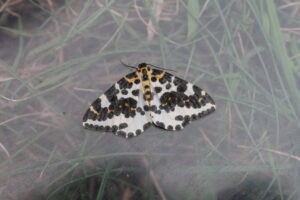
Though named for its resemblance to the magpie bird, which is itself an omen in folklore, a thief of shiny things, this moth behaves more like a ghost that wants to be seen. The one I photographed would take off at any little movement. I could imagine it bursting from a lancet window at Whitby Abbey as Demeter, Dracula’s death-ship, crashes ashore.
Lime-speck Pug (Eupithecia centaureata)
Tiny, ash-flecked, and easily missed, the Lime-speck Pug is one of our curator Patricks’s favorite moths. To me it conjured up the image of an incomplete skull, so it felt obligatory to include the miniature flyer with this theme.
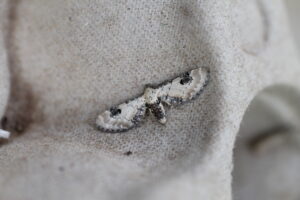
The larvae of the Lime-Speck Pug feed on yarrow, ragwort, and other low flowers that can spring up in broken chapels and sunlit rubble. Its wings are white smudged with charcoal, like soot on limestone, or the outline of a skull in dust. At twilight, it glimmers and disappears, like the faint lantern light carried through a ruined refectory in a ghost story.
Dracula’s Moth Form?
I recently traveled to see Whitby Abbey for myself. Dracula was on my high school reading list, but since my associations with the novel were that of school essays and assignments, I never took the time to research the settings and folklore that influenced Stoker’s most famous work.
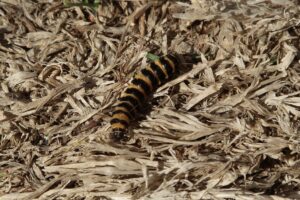
The views from high up on the coastline were so inspiring that I decided to walk the 6.5 miles from Whitby Abbey over to the neighboring village of Robin Hood’s Bay. While en route I nearly squashed a little striped creature sauntering across the dirt pathway.
After a summer of moth-ing, I couldn’t pass up the opportunity for a possible moth ID. Would this orange and black larva confirm my theories about an abbey’s most likely residents?
A reverse Google Image search announced the presence of a Cinnabar (Tyria jacobaeae) larva, which feeds primarily on ragwort. This made perfect sense, as I’d already snapped dozens of photos of that same small yellow flower flooding the fields surrounding Whitby Abbey.
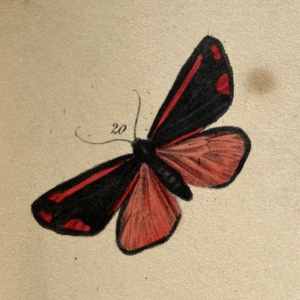
Looking up a picture of the adult moth yielded an even more thematic find. The Cinnabar moth instantly evoked the image of Count Dracula’s stereotypical garb, with long black velvet wings hiding a crimson red lining. In the novel, Dracula has the terrifying ability to shapeshift. While the villain is described taking the form of a bat, wolf, and even mist, a moth form is never mentioned. I can’t believe Stoker passed up the opportunity, as the Cinnabar is exactly how I’d imagine it. Perhaps he never had the pleasure of making the moth’s acquaintance.
*Moths mentioned caught in trap on July 24, 2025
Post by Sophia Hernandez (UPenn intern)
Recent Moths
- Rise of the AI Naturalist
- Best Moths for a Haunted Abbey
- The Real and Fake Deaths of Moths
- The Colonizers of Yorkshire
- Glamour in the Dark: Two Newcomers Arrive at Shandy Hall
- 25 July 2023 – Collective Noun for Hawkmoths
- MOTH LIST to August 2023 with links
- 28 July 2023 – TRIPLE New Species Alert!
- 18 July 2023 – A Golden…Plusia!
- 13 July 2023 – Arts and Sciences
- 10 July 2023 – Rise of the Yellow Underwings
- 4 July 2023 – Cold-weather Catch






